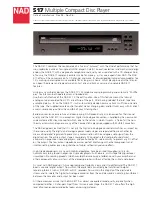
Selenio X100
Installation and Operation Manual
88
Audio Metadata
The audio metadata feature de-embeds audio metadata from various sources and then
re-embeds the audio metadata into multiple outputs. The audio metadata source may be
one of the following:
Metadata embedded in SDI (Methods A and B)
Input of the serial port
Metadata generator
The audio metadata may be inserted into the following outputs:
SDI 1 and SDI 2 (Methods A and B)
Serial port
The Selenio X100 support audio metadata insertion to video output, and extraction from
video input. The modules are also capable of the following:
Generating audio metadata
Receiving audio metadata from the serial port and Dolby decoder
Transmitting audio metadata to the serial port and Dolby decoder
Also see the
Data Embedding and De-Embedding
blocks.Audio TSG
The test signal generator can be routed to any output (embedder, AES, Analog or HDMI).
Test Tone Proc Ch (LOV Mute)
selects the associated video processing channel loss of
video mute mode.
GPI and Rules Engine
GPI
The Selenio X100 provides eight GPI pins for automation, with configurable input or output
directions. The GPIs are open collector style, with approximately 10 K
pull-ups to +5V. In
other words, you can use contact closure-to-ground switches to control these GPI inputs.
All GPI related parameters can be found under
Control > GPI
.
Table 3-12
Test Tone Specifications
Test Tone
Frequency
Level
Test Tone 400 Hz
400 Hz
-36 to 0 dBFs (-18)
Test Tone 1 KHz
1 KHz
-36 to 0 dBFs (-18)
Test Tone 2 KHz
2 KHz
-36 to 0 dBFs (-18)
Test Tone 4 KHz
4 KHz
-36 to 0 dBFs (-18)
EBU R68
1 KHz
-18.06 dBFs
SMPTE RP155
1 KHz
-20 dBFs
Summary of Contents for Selenio X100
Page 8: ...Selenio X100 Installation and Operation Manual viii...
Page 21: ...Selenio X100 Installation and Operation Manual 9 Figure 1 5 X100 Signal Flow...
Page 22: ...Selenio X100 Installation and Operation Manual 10...
Page 38: ...Selenio X100 Installation 26...
Page 158: ...Appendix A Laser Safety Guidelines 146...
Page 178: ...166...
















































